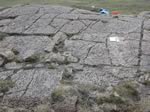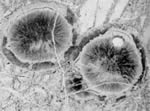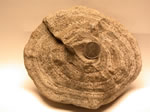|
• Branching
Plagioclase • Variolites • Komatiites • Rapakivi
Granite• Oscillatory
Mineral Zoning •
• Branching
Mineral Growth • Archean
Volcanology• Land
Rovers • |
Ever wonder how those beautiful agates that adorn coffee
tables form? Me too – they form by a process
called self-organization. The pattern
arises spontaneously through the growth process generally
in systems driven far from equilibrium by sudden cooling,
mixing etc. Although I have never worked on agates,
our group has worked on a variety of self-organized
textures including orbicules from
California, Spherulitic
basalts from all over, Spinifex & harrisitic
olivine from Northern Canada, stellate
plagioclase from Scotland, branching
sphalerite from the Northwest Territories Canada, granophyre from
the Sudbury Igneous complex (Ontario), oscillatory
zoned plagioclase from Montserrat, Caribbean and oscillatory
zoned zircon.
My main interest is in the study of
far from equilibrium processes in igneous petrology,
chiefly textures in Archean volcanic rocks. At present
we are working on a unique suite of pillowed dacitic
rocks in the Timmins, Ontario area. These rocks, like
the Archean variolitic
basalts and komatiites we
have worked, on are pretty much restricted to the Archean
because of its unique thermal regime. This has led to
applied research because some of these rocks appear to
be preferred hosts for gold mineralization within the
Abitibi. Accordingly, we (Ph.D. student Etienne Dinel & I)
are also researching the host rock chemistry and volcanology
at the Hoyle Pond Mine, Timmins ON. All projects involve
field work and careful petrography in order to understand
the setting of the texture and collect specimens correctly.
From there we characterize materials using beam techniques
and if possible quantify the data using geometric or
series analysis techniques in order to model possible
dynamics.
Research highlights have been:
Future projects to be started over the
short term include the following. If you are interested
in one of these or alternatively wish to suggest a research
project please contact
me.
Modelling
of Stellate plagioclase growth, Isle of Rum, Scotland.
Volcanology
of the Tisdale Assemblage Rocks, Timmins Ontario.
A
detailed model of komatiite cooling.
|
• Branching
Plagioclase • Variolites • Komatiites • Rapakivi
Granite• Oscillatory
Mineral Zoning •
• Branching
Mineral Growth • Archean
Volcanology• Land
Rovers • |
|

Branching plagioclase
within troctolite Isle of Rum. |
Branching
Plagioclase, Isle of Rum
This project is on some unusual branching plagioclase
in conjunction with H. Emeleus Durham University.
The unusual textures are composed of dm-scale branching
arrays of plagioclase within felspathic peridotite
- troctolite of the Rum Central Complex. The work
forms the M.Sc project of Francoise Labonté.
The rocks were mapped and sampled in July 2001. Working
hypotheses are that; the textures represent far from
equilibrium crystal growth (e.g. Donaldson et. al.,
1973), they are due to viscous fingering, or they
are organized chains of plagioclase. Research is
designed to test these hypotheses and to fully document
the geometry and chemistry of the plagioclase texture
in order to simulate its formation.
<< back to top >> |
|

Spherulites approximately
1mm in size within Archean pillow basalt. |
Variolites
of the Abitibi Greenstone Belt
For years these enigmatic textures were considered
to be due to liquid silicate immiscibility. Strictly
a variole is a centimetric-scale globular leucocratic
texture found on the weathered surface of mafic (generally
volcanic) rocks. Our work (Fowler et. al., 2002;
Fowler et. al., 1986) shows that there are two types
within the Archean Abitibi subprovince of Québec
and Ontario. One group turns out to be plagioclase
spherulites that were formed as a result of chilling
superheated basalt. The other is composed of mingled
rhyolitic and basaltic lavas. The latter type are
the focus of on-going research. The aim here is to
characterize the two lavas to better understand the
generation of Archean rhyolites and the evolution
of the mingled Archean rhyolites. The work has potential
implications for gold mineralization in the area
as shown by the recent M.Sc thesis by Ropchan (e.g.
Ropchan et. al., 2002). Ph.D. student Etienne Dinel
is working on some extremely well preserved sections
of variolitic rocks from the Timmins and Harker-Holloway
areas of the Abitibi. In addition, M.Sc. student
Genévieve Leblanc is currently working on
mineralized rocks in the Shining Tree area of the
Abitibi.
<< back to top >> |
|

Platy crystals of relict
olivines approx. 1mm thick with spherulitic cpx in
komatiite from Munro Twp. ON. |
Komatiites
Former student Mark Shore and I have worked on the
problem of olivine spinifex development (Shore
and Fowler, 1999). Spinifex which is organized
into spectacular sheave like structures results
from rapid cooling. In essence the rapid and
organized growth involves hydrothermal cooling
of the propagating flow-crust along with constrained
cooling of olivine. In this latter process the
forsterite crystals transfer heat more efficiently
than the liquid from which they grow. This cools
the liquid directly ahead of the crystal thus
promoting growth. Heat is transferred to the
overlying hydrothermally cooled crust. Current
work with Michel Houlé (Ph.D. student)
and colleagues at Laurentian University and the
Ontario Geological Survey is focused on the physical
volcanology and facies architecture of komatiites.
<< back to top >> |
|
|
Rapakivi
Granite
Gabriel Machado is studying the development of this
texture for his Ph.D. in conjunction with Mike Higgins
(Université du Québec à Chicoutimi)
and Ilmari Happala (University of Helsinki). Samples
have been collected and field measurements taken
from the Eurajoki rapakivi/megacrystic granite of
SW Finland. In order to test for ripening or other
processes during the mineral growth Gabriel is doing
crystal size distribition analyses.
<< back to top >> |
|
|
Oscillatory
Mineral Zoning
Numerous minerals of which plagioclase is the archetype
have a characteristic oscillatory zoning (Shore and
Fowler, 1996). Our work and that of colleagues demonstrates
that the zoning is inherent to the crystal growth
dynamics and not a reflection of bulk changes within
the system from which the crystal grows. The oscillatory
growth mode appears under non-equilibrium conditions
and involves a feedback between the crystal and the
liquid from which it grows. Collaboration with Ivan
L’Heureux in the department of physics has
led to the development of quantitative models for
the feldspar oscillatory growth, and recent findings
have resulted in a data-driven model of zircon oscillatory
growth (Fowler et. al., In press).
<< back to top >> |
|

Orbicule from Fisher
Lake California, dime (1.8cm) for scale. |
Branching
Mineral Growth
Some mineral growth results in fractal patterns that
can be quantitatively described and modelled (Fowler
et. al., 1989; Fowler and Roach, 1996). The realization
that the textures are fractal objects and can be
simulated using diffusion limited aggregation places
constraints upon the conditions of growth. This can
then be used to infer and understand geological conditions.
Dolores Durant recently completed her Ph.D. on the
organization of orbicles from Fisher Lake California.
The orbicules consist of shells of alternating mineral
composition that have nucleated on cm-scale cores.
Some of the minerals within the cores are characterized
by a branching texture indicative of far from equilibrium
growth conditions. In addition plagioclase and orythopyroxene
are reversed zoned. Durant and Fowler (2002) demonstrate
that the zoning and branching arises as a result
of relatively fast growth during magma mingling.
We have documented branching galena associated with
banded sphalerite of many Mississippi valley-type
deposits (Fowler and L’Heureux, 1996). We think
that in general the mineral patterning arises due
to the introduction mixing of metliferous brines
and their mixing with sulphurous gases within carbonate
host rocks.
Ann Theriault recently completed her Ph.D. on the
evolution of the Sudbury Igneous Complex. An outstanding
feature of the complex are the widespread granophyres,
and graphic textured rocks. These include branchng
textures quartz and feldspar. We show that although
the textures are what one expects of quickly cooled
volcanic rocks, they formed in response to exsolution
of a fluid phase at depth (Thériault et. al.,
2002). Further study of the evolution of these textures
and their associated inclusions may very well be
useful in constraining the development of hydrothermal
fluids of the area.
<< back to top >> |
|
|
Archean
Volcanology
Through some of our early work on variolites former
M.Sc. student Murray Jones discovered an intriguing
and very well preserved volconoclastic deposit that
recently we (with former students Craig, Scott and
Dominque Richard) have determined to be a subaqueous
pyroclastic flow. The rocks have clear evidence of
having been deposited hot and under water (Scott
et. al., Submitted). Much of graduate student work
on projects within the Abitibi require careful mapping
and the identification of volcanic lithofacies.
<< back to top >> |
|

February, but not the
Caribbean. |
Land
Rovers
I grew up with these amazingly versatile though cantankerous
(see the video The God's Must Be Crazy) vehicles
and know them extremely well. As a consequence they
(so-called series vehicles and defenders) are my
vehicle of choice for exploration under difficult
conditions. Unfortunately (?) this Land-Rover genetic
defect seems to run in the family as my 20 year-old
son is restoring the vehicle his grandfather used
to drive over forty years ago!
<< back to top >> |
|
|